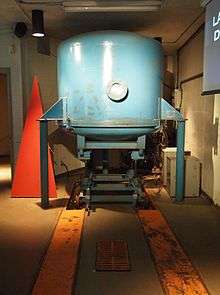Silvering
Silvering is the chemical process of coating glass with a reflective substance. When glass mirrors first gained widespread usage in Europe during the 16th century, most were silvered with an amalgam of tin and mercury,[1] but by the 19th century mirrors were commonly made through a process by which silver was coated onto a glass surface. Today, sputtering aluminium or other compounds are more often used for this purpose, although the process may either maintain the name "silvering" or be referred to as aluminising.
History

The earliest mirrors were made from polished obsidian during the Stone Age.[2] By the Bronze Age most cultures had adopted mirrors made from polished discs of bronze, copper or other metals.[2] Such metal mirrors remained the norm through to Greco-Roman Antiquity and throughout the Middle Ages in Europe.[3] In the 1st century CE glass mirrors began to appear, now believed to have originated in Sidon in present-day Lebanon.[4] Ptolemaic Egypt had manufactured small glass mirrors backed by lead, tin, or antimony.[2] In the early 10th century, the Persian scientist al-Razi described ways of silvering and gilding in a book on alchemy, but this was not done for the purpose of making mirrors.
Thin tinplate or tinfoil used to silver mirrors became known as "tain".[5]
In 1835 German chemist Justus von Liebig developed a process for depositing silver on the rear surface of a piece of glass; this technique gained wide acceptance after Liebig improved it in 1856.[6][7] The process was further refined and made easier by French chemist Tony Petitjean (1857). This reaction is a variation of the Tollens' reagent for aldehydes. A diamminesilver(I) solution is mixed with a sugar and sprayed onto the glass surface. The sugar is oxidized by silver(I), which is itself reduced to silver(0), i.e. elemental silver, and deposited onto the glass.
In 1856-57 Karl August von Steinheil and Léon Foucault introduced the process of depositing an ultra-thin layer of silver on the front surface of a piece of glass, making the first optical-quality first surface glass mirrors, replacing the use of speculum metal mirrors in reflecting telescopes.[8] These techniques soon became standard for technical equipment.
An aluminum vacuum-deposition process invented in 1930 by Caltech physicist and astronomer John Strong, led to most reflecting telescopes shifting to aluminum.[9] Nevertheless, some modern telescopes use silver, such as the Kepler space observatory.[10][11] The Kepler mirror's silver was deposited using ion assisted evaporation.[10][11]
Modern silvering process

In modern aluminum silvering, a sheet of glass is placed in a vacuum chamber with electrically heated nichrome coils that can evaporate aluminum. In a vacuum, the hot aluminum atoms travel in straight lines. When they hit the surface of the mirror, they cool and stick. Some mirror makers evaporate a layer of quartz on the mirror; others expose it to pure oxygen or air in an oven so that it will form a tough, clear layer of aluminum oxide.
Mirrors made by this method are classified as either back-silvered, with the silvered layer viewed through the glass; or front-silvered, (called a first surface mirror) with the reflective layer on the surface towards the incoming light or image. Most common household mirrors are back-silvered, since this protects the fragile reflective layer from corrosion, scratches, and other damage. However, precision optical surfaces normally need the reflective material on the front surface of the glass to avoid introducing optical aberrations. First surface mirrors use the substrate to keep form. There are optical mirrors such as mangin mirrors that are back-silvered (reflective coating on the rear surface) as part of their optical design.
Although the silvering on a second surface mirror such as a household mirror is often actual silver the "silvering" on precision optical instruments such as telescopes is usually aluminum. Even though silver has the best initial front-surface reflectivity in the visible spectrum it is unsuitable for optical mirrors because it quickly oxidizes and absorbs atmospheric sulfur to create a dark, low-reflectivity tarnish. Although aluminum also oxidizes quickly, the thin aluminum oxide (sapphire) layer is transparent, and so the high-reflectivity underlying aluminum stays visible.
The "silvering" on infrared instruments is usually gold. It has the best reflectivity in the infrared spectrum, and has high resistance to oxidation and corrosion.
See also
- Dielectric mirror
- List of telescope parts and construction
- Optical coating
- Mercury glass
- Mercury silvering
- Metallizing
- Resilvering
References
- ↑ Kathleen Payne de Chavez. Historic Mercury Amalgam Mirrors: History, Safety and Preservation Spring 2010. http://www.williamstownart.org/techbulletins/images/WACC%20Historic%20Mercury%20Mirrors.pdf |accessdate= 11 March 2014
- 1 2 3 Fioratti, Helen. "The Origins of Mirrors and their uses in the Ancient World". L'Antiquaire & the Connoisseur. Retrieved 2009-08-14.
- ↑ "A Brief History of Mirrors". Encyclopædia Britannica. Retrieved 2009-08-14.
- ↑ Holland, Patricia. "Mirrors". Isnare Free Articles. Retrieved 2009-08-14.
- ↑ "tain". Oxford English Dictionary (1st ed.). Oxford University Press. 1933.
- ↑ Justus Liebig (1835). "Ueber die Producte der Oxydation des Alkohols". Annalen der Chemie. 14 (2): 133. doi:10.1002/jlac.18350140202.
- ↑ Justus Liebig (1856). "Ueber Versilberung und Vergoldung von Glas". Annalen der Chemie und Pharmacie. 98 (1): 132–139. doi:10.1002/jlac.18560980112.
- ↑ Mazing-space.stsci.edu - Era of Huge Reflectors
- ↑ "Mirror, Mirror: Keeping the Hale Telescope optically sharp" by Jim Destefani, Products Finishing Magazine, 2008
- 1 2 Fulton L., Michael; Dummer, Richard S. (2011). "Advanced Large Area Deposition Technology for Astronomical and Space Applications". Vacuum & Coating Technology (December 2011): 43–47. Retrieved 6 April 2013.
- 1 2 "Ball Aerospace Completes Primary Mirror and Detector Array Assembly Milestones for Kepler Mission". spaceref.com. September 25, 2007. Retrieved 6 April 2013.
|first1=missing|last1=in Authors list (help)
External links
- Tions.net, Diy mirror / mirroring / silvering